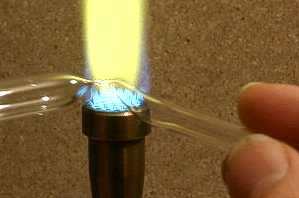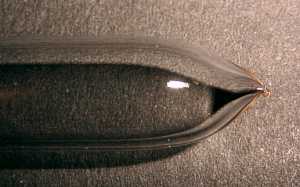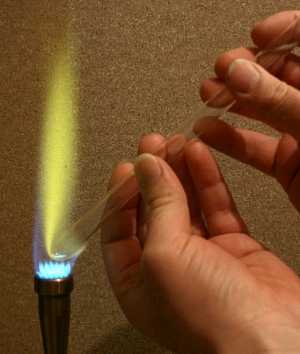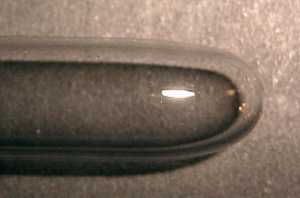
Glass Blowing for Vacuum Devices
Blowing Bulbs
To blow a bulb on the end of a tube, it is first necessary to obtain a sealed tube end.
If the bulb is to be employed for vacuum work, the seal must be gas tight. It is possible
to seal the end of the tube by rotating the tube in a high flame at a steep angle, as in
rounding the end of a tube as described previously, but continuing until the end of the
tube collapses. I have found that this method is very prone to leaving a small pin hole in
the end of the tube. It can be very difficult to get it to fully seal.
I had to stop at times to take photographs, but it is best to work through all of the
following stages without stopping. This avoids having to keep heating the glass back up
from room temperature and reduces the risk of cracking.
 Starting with a 330mm long 12mm diameter tube, I introduce a point 80mm from one end
to a medium flame. To reduce waste I sometimes start with a 250mm length and join it to
a scrap piece of tube with the same diameter. I rotate the tube in the flame using both
hands.
Starting with a 330mm long 12mm diameter tube, I introduce a point 80mm from one end
to a medium flame. To reduce waste I sometimes start with a 250mm length and join it to
a scrap piece of tube with the same diameter. I rotate the tube in the flame using both
hands.
The lower surface of the tube should be just above the bright blue part of the flame.
This is the hottest part of the flame. I continue rotating the tube in the flame until
it begins to soften.
 When the glass softens, the flame turns orange and then yellow. I then draw the two halves
of the tube apart. The tube thins in the middle as can be seen in the picture. It is
important not to draw the two halves apart too fast or a long cone shaped end results.
I try to get the end of the longer part of the tube to collapse without extending very much.
I keep the middle part in the flame so that it collapses and seals. Finally, I draw the
two halves completely apart.
When the glass softens, the flame turns orange and then yellow. I then draw the two halves
of the tube apart. The tube thins in the middle as can be seen in the picture. It is
important not to draw the two halves apart too fast or a long cone shaped end results.
I try to get the end of the longer part of the tube to collapse without extending very much.
I keep the middle part in the flame so that it collapses and seals. Finally, I draw the
two halves completely apart.
 Excess glass can be drawn away using another piece of glass. I keep repeating this until
the length of the cone is less than the diameter of the tube, but more than the radius.
The result of this can be seen in the next picture.
Excess glass can be drawn away using another piece of glass. I keep repeating this until
the length of the cone is less than the diameter of the tube, but more than the radius.
The result of this can be seen in the next picture.
 This is how it looks after drawing off the excess glass. The end of the tube should
still be completely sealed and should not be significantly thinner than the wall
thickness.
This is how it looks after drawing off the excess glass. The end of the tube should
still be completely sealed and should not be significantly thinner than the wall
thickness.
It is essential that the open end is rounded over so that there are no sharp edges, as
it is put in the mouth to blow the bulb. How this is done is described on the Cutting
Tubes page.
 I rotate the end of the tube in the flame at an angle using both hands. I then remove
it from the flame, put the open end in my mouth and blow, gently at first and then harder.
The aim is to get the end round like a test tube bottom. It is safest to do this in several
stages with the glass only just as hot as required. I heat it a little more each time to
find the correct temperature.
I rotate the end of the tube in the flame at an angle using both hands. I then remove
it from the flame, put the open end in my mouth and blow, gently at first and then harder.
The aim is to get the end round like a test tube bottom. It is safest to do this in several
stages with the glass only just as hot as required. I heat it a little more each time to
find the correct temperature.
It is important not to blow while the end of the tube is still in the flame. If this is
done, it will be hotter on one side and will blow out suddenly and unevenly.
 This is how it looks after blowing the end round. The end should be completely smooth.
This is how it looks after blowing the end round. The end should be completely smooth.
The bulb can not be blown to full size in one go, or it would end up too thin. It must
be started in stages.
 The end of the tube is then heated again, while rotating it all the time in a horizontal
position. I lick my lips so that the tube will rotate in my mouth. I remove the tube from
the flame and put the open end in my mouth. I keep the tube rotating and blow gently at
first. I puff my cheeks out so as to get more control. If it is not hot enough, I return
it to the flame and try again. It is best to have the glass just hot enough to work and
it is important not to blow while the tube is in the flame. I blow a small bulb on the
end as shown in the picture.
The end of the tube is then heated again, while rotating it all the time in a horizontal
position. I lick my lips so that the tube will rotate in my mouth. I remove the tube from
the flame and put the open end in my mouth. I keep the tube rotating and blow gently at
first. I puff my cheeks out so as to get more control. If it is not hot enough, I return
it to the flame and try again. It is best to have the glass just hot enough to work and
it is important not to blow while the tube is in the flame. I blow a small bulb on the
end as shown in the picture.
 I then repeat the process just next to the first bulb. I blow out a second bulb of a
similar diameter to the first. It must be rotated faster now because there is more
weight on the softened section. I then heat both bulbs and blow gently, allowing them
to merge together.
I then repeat the process just next to the first bulb. I blow out a second bulb of a
similar diameter to the first. It must be rotated faster now because there is more
weight on the softened section. I then heat both bulbs and blow gently, allowing them
to merge together.
 This is the result of the previous step. It will be blown out into a spherical
bulb at this stage, but a larger bulb could be made by blowing a third bulb next to
the first two. If I were using a burner with a smaller flame, it may be necessary to do
this anyway.
This is the result of the previous step. It will be blown out into a spherical
bulb at this stage, but a larger bulb could be made by blowing a third bulb next to
the first two. If I were using a burner with a smaller flame, it may be necessary to do
this anyway.
 I heat the expanded section as evenly as I can. The tube must be rotated very fast now
or the end will sag. I only need to blow gently now because it is so much thinner.
It is important to keep it rotating even while blowing. I repeat this stage until a
perfectly spherical bulb is obtained. On the final blowing stage, I gradually
blow harder as the glass hardens. I find that this helps to produce a more spherical
bulb.
I heat the expanded section as evenly as I can. The tube must be rotated very fast now
or the end will sag. I only need to blow gently now because it is so much thinner.
It is important to keep it rotating even while blowing. I repeat this stage until a
perfectly spherical bulb is obtained. On the final blowing stage, I gradually
blow harder as the glass hardens. I find that this helps to produce a more spherical
bulb.
 This is the completed bulb. It is 42mm in diameter and has an even wall thickness.
blowing in three stages rather than two produces a bulb which is about 50mm in diameter
using my burner.
This is the completed bulb. It is 42mm in diameter and has an even wall thickness.
blowing in three stages rather than two produces a bulb which is about 50mm in diameter
using my burner.
 Starting with a 330mm long 12mm diameter tube, I introduce a point 80mm from one end
to a medium flame. To reduce waste I sometimes start with a 250mm length and join it to
a scrap piece of tube with the same diameter. I rotate the tube in the flame using both
hands.
Starting with a 330mm long 12mm diameter tube, I introduce a point 80mm from one end
to a medium flame. To reduce waste I sometimes start with a 250mm length and join it to
a scrap piece of tube with the same diameter. I rotate the tube in the flame using both
hands.
 When the glass softens, the flame turns orange and then yellow. I then draw the two halves
of the tube apart. The tube thins in the middle as can be seen in the picture. It is
important not to draw the two halves apart too fast or a long cone shaped end results.
I try to get the end of the longer part of the tube to collapse without extending very much.
I keep the middle part in the flame so that it collapses and seals. Finally, I draw the
two halves completely apart.
When the glass softens, the flame turns orange and then yellow. I then draw the two halves
of the tube apart. The tube thins in the middle as can be seen in the picture. It is
important not to draw the two halves apart too fast or a long cone shaped end results.
I try to get the end of the longer part of the tube to collapse without extending very much.
I keep the middle part in the flame so that it collapses and seals. Finally, I draw the
two halves completely apart. Excess glass can be drawn away using another piece of glass. I keep repeating this until
the length of the cone is less than the diameter of the tube, but more than the radius.
The result of this can be seen in the next picture.
Excess glass can be drawn away using another piece of glass. I keep repeating this until
the length of the cone is less than the diameter of the tube, but more than the radius.
The result of this can be seen in the next picture. This is how it looks after drawing off the excess glass. The end of the tube should
still be completely sealed and should not be significantly thinner than the wall
thickness.
This is how it looks after drawing off the excess glass. The end of the tube should
still be completely sealed and should not be significantly thinner than the wall
thickness. I rotate the end of the tube in the flame at an angle using both hands. I then remove
it from the flame, put the open end in my mouth and blow, gently at first and then harder.
The aim is to get the end round like a test tube bottom. It is safest to do this in several
stages with the glass only just as hot as required. I heat it a little more each time to
find the correct temperature.
I rotate the end of the tube in the flame at an angle using both hands. I then remove
it from the flame, put the open end in my mouth and blow, gently at first and then harder.
The aim is to get the end round like a test tube bottom. It is safest to do this in several
stages with the glass only just as hot as required. I heat it a little more each time to
find the correct temperature. This is how it looks after blowing the end round. The end should be completely smooth.
This is how it looks after blowing the end round. The end should be completely smooth. The end of the tube is then heated again, while rotating it all the time in a horizontal
position. I lick my lips so that the tube will rotate in my mouth. I remove the tube from
the flame and put the open end in my mouth. I keep the tube rotating and blow gently at
first. I puff my cheeks out so as to get more control. If it is not hot enough, I return
it to the flame and try again. It is best to have the glass just hot enough to work and
it is important not to blow while the tube is in the flame. I blow a small bulb on the
end as shown in the picture.
The end of the tube is then heated again, while rotating it all the time in a horizontal
position. I lick my lips so that the tube will rotate in my mouth. I remove the tube from
the flame and put the open end in my mouth. I keep the tube rotating and blow gently at
first. I puff my cheeks out so as to get more control. If it is not hot enough, I return
it to the flame and try again. It is best to have the glass just hot enough to work and
it is important not to blow while the tube is in the flame. I blow a small bulb on the
end as shown in the picture. I then repeat the process just next to the first bulb. I blow out a second bulb of a
similar diameter to the first. It must be rotated faster now because there is more
weight on the softened section. I then heat both bulbs and blow gently, allowing them
to merge together.
I then repeat the process just next to the first bulb. I blow out a second bulb of a
similar diameter to the first. It must be rotated faster now because there is more
weight on the softened section. I then heat both bulbs and blow gently, allowing them
to merge together. This is the result of the previous step. It will be blown out into a spherical
bulb at this stage, but a larger bulb could be made by blowing a third bulb next to
the first two. If I were using a burner with a smaller flame, it may be necessary to do
this anyway.
This is the result of the previous step. It will be blown out into a spherical
bulb at this stage, but a larger bulb could be made by blowing a third bulb next to
the first two. If I were using a burner with a smaller flame, it may be necessary to do
this anyway. I heat the expanded section as evenly as I can. The tube must be rotated very fast now
or the end will sag. I only need to blow gently now because it is so much thinner.
It is important to keep it rotating even while blowing. I repeat this stage until a
perfectly spherical bulb is obtained. On the final blowing stage, I gradually
blow harder as the glass hardens. I find that this helps to produce a more spherical
bulb.
I heat the expanded section as evenly as I can. The tube must be rotated very fast now
or the end will sag. I only need to blow gently now because it is so much thinner.
It is important to keep it rotating even while blowing. I repeat this stage until a
perfectly spherical bulb is obtained. On the final blowing stage, I gradually
blow harder as the glass hardens. I find that this helps to produce a more spherical
bulb. This is the completed bulb. It is 42mm in diameter and has an even wall thickness.
blowing in three stages rather than two produces a bulb which is about 50mm in diameter
using my burner.
This is the completed bulb. It is 42mm in diameter and has an even wall thickness.
blowing in three stages rather than two produces a bulb which is about 50mm in diameter
using my burner.